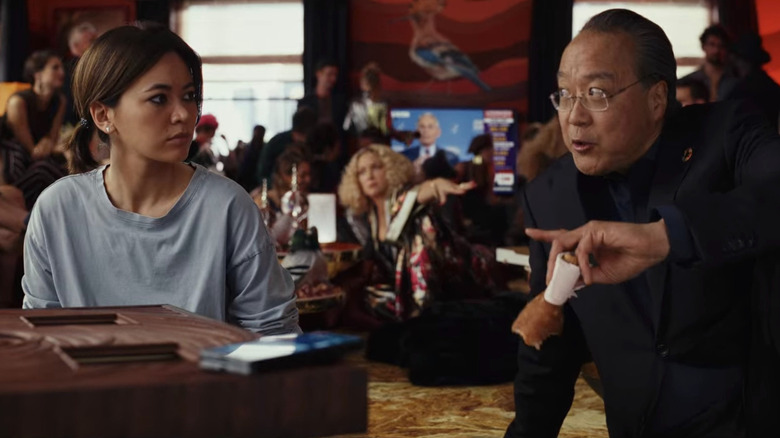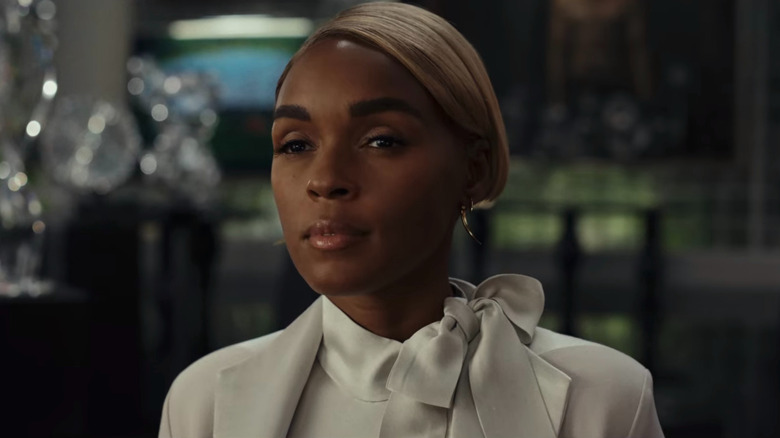Yo-Yo Ma Rewrote His Own Glass Onion Scene
This post contains spoilers for "Glass Onion: A Knives Out Mystery."
One of the great joys seeing Rian Johnson's latest whodunnit "Glass Onion: A Knives Out Mystery" in a theater was hearing the reaction of the audience whenever there was a cameo from a very famous person. Nothing about this murder mystery from the outset signals that these celebrities will show up, making them even more delightful when they do.
The very first cameo comes at the definitely not COVID-safe house party thrown by Kate Hudson's Birdie Jay. After receiving her puzzle box invitation from Edward Norton's Miles Bron, one of the party guests that helps solve one of the puzzles is legendary cellist Yo-Yo Ma who is in attendance and chomping on a slice of pizza. In his cameo, he explains the structure of a fugue, which is a piece of music that essentially layers over the top of itself to create something new.
Rian Johnson may understand the theory of a fugue, but perhaps not the proper words to describe it. Luckily, he had one of the greatest musicians in the world there with him, and Yo-Yo Ma thought this fugue explanation could use a little work. On the latest episode of The Filmcast, Johnson recalls how the cellist asked to alter the script of his cameo:
"He rewrote me. He was so sweet. He was on set, and he came up and was [sic] like, 'Could I make a couple little tweaks?' I'm like, 'Yo-Yo Ma, are you asking me if you can put in your own words the fugue explanation? The answer is yes.'"
Yo-Yo Ma wasn't improving this explanation just for the betterment of the gag. In that moment, he is actually telling you exactly how the rest of the film is going to play out.
He explains the entire structure of the movie
Part of the reason why Janelle Monáe has rightfully racked up quite a few Best Supporting Actress wins and nominations this awards season from various critics groups is due in large part to how Rian Johnson has structured "Glass Onion." Halfway through the film, we jump back to the beginning of the story, and instead of Daniel Craig's Benoit Blanc being the protagonist, we now repeat everything we saw in the first half but through the eyes of Janelle Monáe's Helen, who is pretending to be her murdered twin sister Andi.
If that structure sounds familiar, that's because it is a fugue. Within the first 10 minutes of the film, Yo-Yo Ma explicitly tells you exactly how the story of "Glass Onion" is going to be told, and not one of us caught it. By structuring the story this way, the film constantly reveals to us new ways to interpret and understand what we had seen before, and the results are either hilarious, tragic, exciting, or some mixture of the three. This also allows us to see so much more dimensionality within Monáe's performance that we couldn't even have imagined was there before.
In that episode of The Filmcast, Rian Johnson says, "The first thing I started with — the first kind of, 'Okay, I've got something here' — was ... the notion of the fugue structure." The success of the entire film hinged on successfully pulling off that structure. Understanding it was vital for "Glass Onion," and I'm glad he had a world-renowned musician in Yo-Yo Ma there to clarify it perfectly for the audience, making us all look dumb that we didn't clock it.

